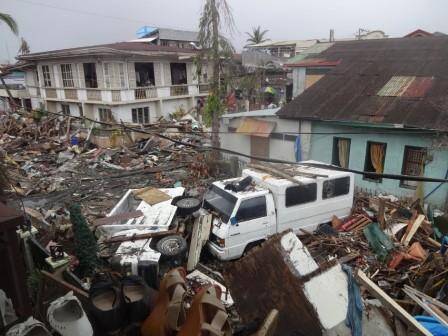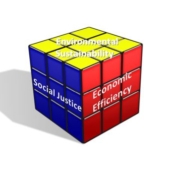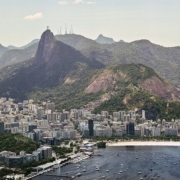The Silver Lining of the COVID-Caused Recession is Fading Fast
by Madeline Baker
From February to mid-April 2020, in an early and shocking stage of the COVID-19 pandemic, greenhouse gas emissions plummeted worldwide. Nowhere was the reduction more notable than in China, the country with the highest emissions. According to Lauri Myllyvirta, the lead analyst at the Centre for Research on Energy and Clean Air, China’s carbon dioxide emissions fell by 25 percent from the end of January through mid-February. Also, for the month of February, average coal consumption at power plants fell to a four-year low, and oil refinery operating rates fell to the lowest level since fall of 2015. This translated to lower levels of nitrous dioxide in China; NO2 levels the week following the Chinese New Year were 36 percent below what they were for the same week the previous year. Meanwhile liquid fuel consumption was 20 to 30 percent lower in March 2020 than in March 2019.
Levels of carbon monoxide were 30-45% lower in the atmosphere in China in February and early March, compared to the same period in 2019. Measurements were made by @NCAR_Science using data from @NASA and @ESA satellites.https://t.co/GbD0dhxkt8 pic.twitter.com/kKcFFWXK2m
— NASA Earth (@NASAEarth) March 27, 2020
NASA tweet demonstrating COVID-caused reduction in CO2 emissions.
Along with reduced carbon emissions, industrial output in China reportedly fell by a whopping 13.5 percent in January and February from the previous year. This translated to an economic contraction of 6.8 percent (annualized rate) for Q1, the first quarter since 1992 with declining GDP! Beijing was so taken aback that, for the first time in 30 years, China has no annual growth target.
Given the clear and significant benefits of the shutdown, not just for China but for the global ecosystem, it seems more than logical to ask: Should China, or any other nation for that matter, be striving for pre-pandemic GDP figures, and thenceforth further growth besides? Why shouldn’t our nations, more or less “united” under a UN charter, focus instead on combating the next deadly crisis, or protecting the environment, or the diplomacy of peacekeeping?
Unfortunately, these questions are becoming moot, especially for China, which is already ramping up to pre-pandemic industrial capacity. The Chinese appear to be focusing heavily on power generation, increasing capital spending on utilities by 14 percent from January-May compared to the same period last year, “even as overall capital spending fell by six percent.” China also consumes more coal than any nation by a large margin, and accordingly saw carbon dioxide emissions four-to-five percent higher in May of 2020 compared with May of 2019 as the post-lockdown economic push kicked into high gear. Fortunately, the May spike in CO2 emissions appears to have been temporary, abating in June and allowing for projected overall emissions for 2020 to remain six percent below 2019 levels. Still—a six percent reduction in emissions is a far cry from the initial 25 percent drop we saw during the lockdown period, and a far cry from the kind of reduction we need for serious mitigation of climate change.
Sustainability experts such as Vinod Thomas for the Brookings Institute are urging the public to view the COVID-19 disaster as akin to an environmental crisis, most notably climate change. Bill Gates makes a similar argument. Globally, the death toll from COVID-19 has surpassed 790,000. We cannot know how many will ultimately die from COVID-19, but we do have estimates for the number of deaths already caused by climate change. The World Health Organization, for example, estimates that 150,000 deaths per year are attributable to climate change, and this number will only continue to rise over the next few decades as we’re locked into the momentum of global warming. Shane Skelton, former energy advisor to U.S. House Speaker Paul Ryan, warned that climate change “will be just as bad as coronavirus when we’re really feeling it.” Is anybody listening?
Out of Sight, Out of Mind
For virtually all of modern history up until the outbreak of COVID-19, society has functioned primarily in a growing economy (all the while headed toward limits to growth). Since the outbreak, however, society’s priority has been public health. With this common good as a powerful motivator, people have been making lifestyle changes they would have previously never considered, such as social distancing, wearing masks, and avoiding close contact with family members. Unfortunately, it took a healthy dose of panic and, in many cases, government mandates for individuals to shift their priorities and act accordingly.

The devastating effects of typhoon Haiyan on the Philippines. Another result of man-made climate change killing thousands of people and leaving millions homeless. (CC BY-SA 4.0, Lawrence Ruiz)
So, why is it that despite a large body of evidence warning us of the impending climate crisis, we have been unmotivated to mitigate it? Common sense should reveal that the ecosystem is just as vital a common good as public health, but for many of us in wealthier countries, and particularly in urban areas, the natural environment is somewhat “out of sight, out of mind.” The number of people we find suffering from the effects of climate change is much lower compared to the number of those we know who are sick or dying from COVID-19. While the virus is widespread throughout socioeconomic classes, climate change adversely affects lower-class communities and people in developing countries first and worst. As noted in a study published by the Center for Global Development, “Climate change will be awful for everyone but catastrophic for the poor.”
Further exacerbating the ignorance of the developed world, and especially in the U.S. government, are the vested interests of many powerful players causing climate change. While corporations and political representatives who initially downplayed the effects of the virus have had to renege on their statements due to the massive economic shutdown, the energy majors have been monkeywrenching U.S. policy pertaining to greenhouse gas emissions. For example, Big Oil spent “more than $2 bn…lobbying Congress on climate change legislation between 2000 and 2016.” Expenditures like this make it seem unlikely that we can expect behavioral mandates—federal or state—to mitigate climate change anytime soon.
Sweeping Systemic Change Needed Now
The science is clear and bolstered by evidence from the COVID-caused recession in China: There is a fundamental conflict between economic growth and environmental protection. Recent months have confirmed that a return to our pre-pandemic lifestyle means a return to unsustainable resource extraction and emission rates. Not only have efforts to get the global economy “back on track” come with “compromising global investments in clean energy and weakening industry environmental goals to reduce emissions,” but other lifestyle changes to avoid the virus threaten serious regression in terms of environmental protection. For example, more people are choosing to drive to avoid contracting COVID-19 on public transit, and single-use plastic has become significantly more prevalent in restaurants and food-delivery services as they struggle to keep up with sanitation guidelines.
It’s hard to get enthused about “reduce, reuse, recycle” when we are told that every surface we touch may be contaminated with a deadly virus. Even reverting to pre-pandemic waste practices, which weren’t very sustainable to start with, could take re-education on a massive scale. It just wasn’t wise to get boxed into this corner; up hard against limits to growth.
The global infrastructure vulnerabilities that have been exposed in the struggle to combat the novel coronavirus reveal one thing for sure: Tackling climate change, one of many growth-induced environmental problems, requires an even more systemic approach than recovering from COVID-19. The only solution to these problems is a comprehensive policy shift, first by developed nations, toward a steady state economy, where population and consumption are stabilized within ecological constraints.
If we start to make the transition now, policy reforms could perhaps still be gradual and structured, without the chaos and suffering that comes with a macroeconomic supply shock. We need our leaders and institutions to acknowledge the conflict between economic growth and environmental protection now. Otherwise, we are unmistakably headed for more environmental breakdowns, pandemics, and long-running recessions.
 Madeline Baker is a CASSE intern (spring 2020) and a senior international economics and finance major at the Catholic University of America.
Madeline Baker is a CASSE intern (spring 2020) and a senior international economics and finance major at the Catholic University of America.








Very insightful…
This raises so many vital questions. Is economic growth really always and forever to be our lodestar? Even when the planet is on fire, literally? Thanks Madeleine, excellent article.
It seems like a strange thing to focus on when this time has shown us that so many other things are important, doesn’t it? Thank you for reading!
The data on China provides insight into the return to old paradigms. Time for building back better with policy shifts you suggest — a huge opportunity for the USA and one that I hope we follow. Thanks, Madeline.
Old and outdated for 2020… thank you for reading!